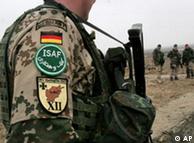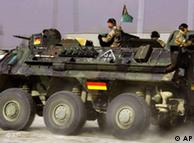 Since late October, German forces in Afghanistan have been involved in Operation "Harekate Yolo II", in some cases seeing heavy fighting. This lasted about two weeks, and has only since last week slowly surfaced.
Since late October, German forces in Afghanistan have been involved in Operation "Harekate Yolo II", in some cases seeing heavy fighting. This lasted about two weeks, and has only since last week slowly surfaced.The operation is a joint NATO effort to regain control of the provinces Badghis and Farjab in north-west Afghanistan. Badghis is part of the Italian Regional Command (West) and Farjab lies next to it in the German Regional Command (North) zone.
Over a few previous weeks, Taliban forces had apparently overrun several districts in both provinces, attacking police stations and local security forces, and taking some measure of control in Badghis province in the Italian zone. There, Taliban units also blocked the "Ring Road" which connects all major Afghan cities. Estimates talk about around organized Taliban units numbering around 300 men in the area, with "not only light weapons".
The primary unit in the operation is the 209th Afghan National Army Corps with up to 900 soldiers deployed, along with its embedded Bundeswehr advisors. Germany also supplied recon forces, medical support and logistics units with up to 300 soldiers deployed. Additionally, some 260 Norwegian soldiers were deployed (including the RC(N) QRF from Mazar-e-Sharif), as well as Italian units and other, smaller NATO groups. The German Regional Command under Brigade General Dieter Warnecke, who lead this operation for ISAF, was forward-deployed to Maimaneh in Farjab province, where the Norwegian PRT is located. RC(N) units were not only deployed in Farjab, but, for some time, also out-of-area in Badghis in the Italian zone.
Fighting to regain Badghis province was apparently heavy. For Norway, newspaper Aftenposten cites the Norwegian Commander that last monday's fighting was the heaviest Norwegian units have been involved in since WW2. No NATO casualties in connection with this operation have so far been reported though.
Apparently, several times, air strikes had to be ordered to support ground forces, in one case killing a high Taliban commander according to NATO (and some civilians by unaccounted Afghan sources). These strikes were directed by German or Norwegian advisors accompanying the Afghan forces. In another case, Norwegian Forces had to call in airstrikes as they came under mortar fire from fortified Taliban positions. German Tornado Recce assets were also heavily used in the operation.

After about two weeks, the operation was declared over last week; German and Norwegian units withdrew back from Badghis to Farjab. Badghis was declared in a "state of consolidation", with other NATO troops stabilizing it, and Afghan forces supposed to take back over "in a few weeks".
Taliban troops in the area are of course not beaten yet. Taliban Commander Mansur Dadullah announced a "new front" in the North a week ago, and yesterday in Farjab, Norwegian forces that were involved in the operation suffered one fatality and one injured from a roadside bomb attack.
Pressure on the region has been increasing over the last two months; German troops had already been involved in - less violent - joint operations with ANA units in the eastern part of its zone. The reason for this increase in pressure is a power vacuum created by the local Warlord General Dostum losing influence and money.
Norway is - in light of this and planned future operations - currently increasing its deployment to Afghanistan, with an extra 50 military advisors for the ANA, and a 150-strong combat company with 2-3 helicopters planned for early 2008. These are specifically planned to "increase presence" in RC(N) and will bring the Norwegian deployment to 700 soldiers total. Germany still has a buffer of about 350 soldiers available in its recently extended mandate in addition to the deployed 3,150 soldiers. Defence Minister Jung announced late October that German military advisor numbers to the ANA would be "tripled". The rest of the buffer - about 250 soldiers - will be filled by German troops replacing 240 Danish and Czech troops in the North. A related measure is probably also that six CH-53 - long planned - finally transferred last week from Task Unit Termez/Uzbekistan to Task Unit Mazar-e-Sharif.
The recent fighting - also in the South and East - is some of the last major operations on both sides before the Afghan Winter will grind everything to a halt later this month. It'll be interesting to see what will happen in spring.
1 comment:
Indeed very interesting. Not just this post but your entire blogg. I will keep an eye on it in the future.
Good Work.
Post a Comment